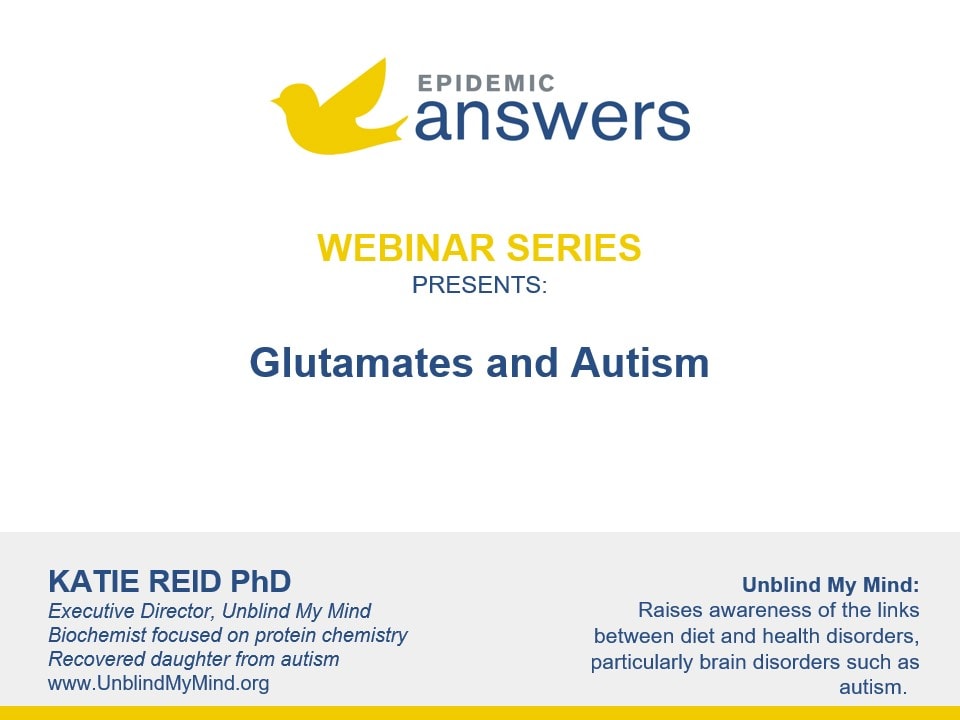What’s Wrong with MSG aka Glutamate?
MSG – monosodium glutamate – is a flavor enhancer that creates the savory “fifth flavor”, umami. MSG and its analogs are known by dozens of other names such as:
- Autolyzed protein
- Hydrolyzed protein
- Corn starch
- Protein isolates
- Yeast extract
- Gelatin
- Barley malt
- Bouillon
- Natural flavoring
- Artificial flavoring
- Soy sauce
Foods can be hiding other forms of glutamate even if MSG isn’t listed on the label. Processed foods contain orders-of-magnitude-higher levels of glutamate versus a few decades ago, as the authors document. The authors prove with peer-reviewed science that glutamate can:
- Damage or kill nerve cells because it is an excitotoxin
- Lead to dysbiosis in the gut microbiome
- Contribute to inflammation in the body
Katie Reid’s Personal Story
In the book, Dr. Reid details her daughter Taylor’s autism reversal, which was achieved gradually, first by making whole-food smoothies, next with the gluten-free/casein-free diet and then finally with the low-glutamate diet. At this point, she began questioning every single ingredient in her daughter’s diet, which led her into a “full-fledged investigation of the food industry.” She also developed the REID (Reduced Excitatory Inflammatory Diet) to help others understand how excess glutamate contributes to autism and other chronic health conditions.
What Else Is in the Book?
This book details Dr. Reid’s research and investigations into the food industry. By reviewing peer-reviewed medical research (see Sources & References, below), she built on the work of neurosurgeon Russell Blaylock’s Excitotoxins: The Taste That Kills. She also discovered how excess glutamate signaling contributes to symptoms of:
- Mood disorders
- Learning disabilities
- Alzheimer’s
- Parkinson’s
- Strokes
- Cancer
- Diabetes
- Obesity
This book is an in-depth investigation of the deceptive practices of the processed-food industry, especially as it relates to what she calls “the food manufacturer’s secret ingredient”, glutamate. Readers will learn about loose regulations and enforcement of the industry, as well as misleading claims on food products and how the word “enzymes” on a food label is a red flag. Readers will also learn how the “glutamate is safe” debate is heavily funded by the food industry.
In later chapters, Dr. Reid explains glutamate signaling in depth, as well as how it and the processed foods it’s commonly found in can damage the health of the gut microbiome and lead to chronic inflammation. These processes are all drivers of chronic health conditions, and Dr. Reid describes how excess glutamate contributes to many of the diagnoses listed above.
The REID Protocol
The final chapter of the book details the REID protocol, of which there are six principles that form its foundation:
- Reduce excitotoxicity
- Reduce inflammation
- Increase fiber from vegetables
- Diversify
- Know where your food comes from and how it’s made
- Embrace the food journey as a lifestyle
From this protocol, Dr. Reid has developed ten goals about how to put REID into practice. These goals have detailed, practical ideas in a well-thought-order designed to create success in following the protocol. The goals are:
- A call to action to redefine food
- Eliminate wheat gluten and processed grains
- Eliminate dairy
- Increase consumption of high-fiber vegetables and herbs throughout the day
- Clean out your environment (start with your kitchen)
- Restock your kitchen
- Eliminate refined sugars and reserve fruit as a treat
- Identify your go-to foods
- Have a quality control plan for consuming foods outside the home
- Embrace the journey toward the perfect plate
Appendix B of the book contains a meal plan and recipes to guide readers into making these changes.
Success is definitely possible in following this protocol. Not only did Dr. Reid’s daughter reverse her diagnosis with this protocol, but you can also read about Patrick and Charlie’s reversal of their autism diagnoses here using the REID protocol.
About Katie Reid PhD
Dr. Katherine Reid is a biochemist and the founder of Unblind My Mind (UMM), a nonprofit 501(c)3 organization dedicated to improving health one bite at a time.
Because she is a biochemist, she researched brain chemistry and discovered that many of the foods she was feeding her daughter were causing her daughter’s autism symptoms. She discovered how free glumates in food can cause symptoms of autism, and her TEDx video Unblind My Mind: What Are We Eating? Dr. Katherine Reid at TEDxYouth@GrassValley has been viewed over 250,000 times.
In graduate school, she studied biochemistry and was a teaching assistant for Chemistry of Nutrition. From a scientific perspective, she appreciated the link between nutrition and vital biochemical functions. Her career has focused on protein chemistry mainly as it applies to developing protein therapeutics.

In graduate school, she studied biochemistry and was a teaching assistant for Chemistry of Nutrition. From a scientific perspective, she appreciated the link between nutrition and vital biochemical functions. Her career has focused on protein chemistry mainly as it applies to developing protein therapeutics.
About Barbara Price PhD
Barbara Price, MS, MA, PhD, has studied topics ranging from climate change to protein biophysics and has turned her passion for science into a career as a science writer and editor.
As a senior science development editor for major educational publishers, she helps textbook authors turn highly technical information into narratives that teach. As an editor and science write, she supports scientists who have their own stories to tell. Price has also authored original content for young learners and general audiences.
She is also an avid gardener and believes that health begins with good food. She lives in northern California.

Sources & References
Bauer, J., et al. Hyperactivity and impulsivity in adult attention-deficit/hyperactivity disorder is related to glutamatergic dysfunction in the anterior cingulate cortex. World J Biol Psychiatry. 2018 Oct;19(7):538-546.
Blaylock, R.L., et al. Natural plant products and extracts that reduce immunoexcitotoxicity-associated neurodegeneration and promote repair within the central nervous system. Surg Neurol Int. 2012;3:19
Blaylock, R.L. A possible central mechanism in autism spectrum disorders, part 1. Altern Ther Health Med. 2008 Nov-Dec;14(6):46-53.
Blaylock, R.L. A possible central mechanism in autism spectrum disorders, part 2: immunoexcitotoxicity. Altern Ther Health Med. 2009 Jan-Feb;15(1):60-7.
Blaylock, R.L. A possible central mechanism in autism spectrum disorders, part 3: the role of excitotoxin food additives and the synergistic effects of other environmental toxins. Altern Ther Health Med. 2009 Mar-Apr;15(2):56-60.
Blaylock, R.L., et al. Immune-glutamatergic dysfunction as a central mechanism of the autism spectrum disorders. Curr Med Chem. 2009;16(2):157-70.
Breitenkamp, A.F., et al. Voltage-gated Calcium Channels and Autism Spectrum Disorders. Curr Mol Pharmacol. 2015;8(2):123-32.
Brown, M.S., et al. Increased glutamate concentration in the auditory cortex of persons with autism and first-degreer elatives: A(1)H-MR study. Autism Res. 2013;6(1):1–10.
Cartmell, J., et al. Regulation of neurotransmitter release by metabotropic glutamate receptors. J Neurochem. 2000 Sep;75(3):889-907.
Chapman, G. Glutamate and epilepsy. J Nutr. 2000 Apr;130(4S Suppl):1043S-5S.
Choudhury, P.R., et al. Glutamate mediated signaling in the pathophysiology of autism spectrum disorders. Pharmacol Biochem Behav 100(2012)841–849
Cocito, L., et al. GABA and phosphatidylserine in human photosensitivity: a pilot study. Epilepsy Res. 1994 Jan;17(1):49-53.
Coghlan, S., et al. GABA System Dysfunction in Autism and Related Disorders: From Synapse to Symptoms. Neurosci Biobehav Rev. 2012;36(9):2044–2055.
Davalli, D.M., et al. The potential role of glutamate in the current diabetes epidemic. Acta Diabetol. 2012 Jun;49(3):167-83.
DeHavenon, A., et al. The Secret “Spice”: An Undetectable Toxic Cause of Seizure. Neurohospitalist. 2011 Oct; 1(4): 182–186.
Ding, H., et al. Molecular Pathogenesis of Anti-NMDAR Encephalitis. Biomed Res Int. 2015;2015:643409.
D’Souza, C.E., et al. GAD65 antibody-associated autoimmune epilepsy with unique independent bitemporal-onset ictal asystole. Epileptic Disord. 2018 Jun 1;20(3):204-208.
Eimerl, S., et al. Acute glutamate toxicity and its potentiation by serum albumin are determined by the Ca2+ concentration. Neurosci Lett. 130 (1991) 125–127.
El-Ansary, A. GABA and Glutamate Imbalance in Autism and Their Reversal as Novel Hypothesis for Effective Treatment Strategy. Autism and Developmental Disorders. 18, no. 3 (2020): 46-63.
Ende, G., et al. Impulsivity and Aggression in Female BPD and ADHD Patients: Association with ACC Glutamate and GABA Concentrations. Neuropsychopharmacology. 2016 Jan;41(2):410-8.
Essa, M.M., et al. Excitotoxicity in the pathogenesis of autism. Neurotox Res. 2013 May;23(4):393-400.
Feng, Z.M., et al. Monosodium L-Glutamate and Dietary Fat Differently Modify the Composition of the Intestinal Microbiota in Growing Pigs. Obes Facts. 2015;8(2):87-100.
Fernell, E. Further studies of GABA and Glutamate imbalances in autism are important challenges for future research. Acta Paediatr. 2019 Feb;108(2):200-201.
Ford, T.C., et al. Psychosocial deficits across autism and schizotypal spectra are interactively modulated by excitatory and inhibitory neurotransmission. Autism. 2019 Jul 24:1362361319866030.
Hacohen, Y., et al. N‐methyl‐d‐aspartate (NMDA) receptor antibodies encephalitis mimicking an autistic regression. Dev Med Child Neurol. 2016 Oct;58(10):1092-4.
Haroon, E., et al. Inflammation, Glutamate, and Glia: A Trio of Trouble in Mood Disorders. Neuropsychopharmacology. 2017 Jan;42(1):193-215.
Hassel, B., et al. Brain infection with Staphylococcus aureus leads to high extracellular levels of glutamate, aspartate, γ-aminobutyric acid, and zinc. J Neurosci Res. 2014 Dec;92(12):1792-800.
Herbert, M.R, et al. Autism and EMF? Plausibility of a pathophysiological link–Part I. Pathophysiology 20.3 (2013): 191-209.
Herbert, M.R., et al. Autism and EMF? Plausibility of a pathophysiological link Part II. Pathophysiology 20.3 (2013): 211-234.
Huang, Y., et al. Pyridoxine Supplementation Improves the Activity of Recombinant Glutamate Decarboxylase and the Enzymatic Production of Gama-Aminobutyric Acid. PLoS One. 2016 Jul 20;11(7):e0157466.
Hughes, R., et al. Protein degradation in the large intestine: relevance to colorectal cancer. Curr Issues Intest Microbiol. 2000 Sep;1(2):51-8.
Humphries, P., et al. Direct and indirect cellular effects of aspartame on the brain. Eur J Clin Nutr. 2008 Apr;62(4):451-62.
Kash, S.F., et al. Epilepsy in mice deficient in the 65-kDa isoform of glutamic acid decarboxylase. Proc Natl Acad Sci U S A. 1997;94(25):14060–14065.
Khalifa, D., et al. Serum glutamate was elevated in children aged 3-10 years with autism spectrum disorders when they were compared with controls. Acta Paediatr. 2019 Feb;108(2):295-299.
Luo, P., et al. The role of glutamate receptors in traumatic brain injury: implications for postsynaptic density in pathophysiology. Brain Res Bull. 2011 Jul 15;85(6):313-20.
, J.Z., et al. Prenatal exposure to fipronil disturbs maternal aggressive behavior in rats. Neurotoxicol Teratol. Nov-Dec 2015;52(Pt A):11-6.
Manev, H., et al. Delayed increase of Ca2+ influx elicited by glutamate: role in neuronal death. Mol Pharmacol. 1989 Jul;36(1):106-12.
McNally, L., et al. Inflammation, glutamate, and glia in depression: a literature review. CNS Spectr. 2008 Jun;13(6):501-10.
Naaijen, J., et al. Fronto-Striatal Glutamate in Autism Spectrum Disorder and Obsessive Compulsive Disorder. Neuropsychopharmacology. 2017 Nov;42(12):2456-2465.
Napolini, V., et al. The mitochondrial aspartate/glutamate carrier AGC1 and calcium homeostasis: Physiological links and abnormalities in autism. Mol Neurobiol. 44 (2011) 83–92.
Onaolapo, A.Y., et al. Glutamate and depression: Reflecting a deepening knowledge of the gut and brain effects of a ubiquitous molecule. World J Psychiatry. 2021 Jul 19;11(7):297-315.
Ou, D., et al. Cross-reactive rubella virus and glutamic acid decarboxylase (65 and 67) protein determinants recognised by T cells of patients with Type I diabetes mellitus. Diabetologia. 2000 Jun;43(6):750-62.
Pall, M.L., The Autism Epidemic Is Caused by EMFs, Acting via Calcium Channels and Chemicals Acting via NMDA-Rs: Downstream Effects Cause Autism (conference presentation). 2015.
Pall, M.L., Electromagnetic fields act via activation of voltage‐gated calcium channels to produce beneficial or adverse effects. Journal of Cellular and Molecular Medicine 17.8 (2013): 958-965.
Palmieri, L., et al. Altered calcium homeostasis in autism-spectrum disorders: evidence from biochemical and genetic studies of the mitochondrial aspartate/glutamate carrier AGC. Mol Psychiatry. 2010 Jan;15(1):38-52.
Pelsser, L.M., et al. Effects of a restricted elimination diet on the behaviour of children with attention-deficit hyperactivity disorder (INCA study): a randomised controlled trial. Lancet. 2011 Feb 5;377(9764):494-503.
Pitt, D., et al. Glutamate excitotoxicity in a model of multiple sclerosis. Nat Med. 2000 Jan;6(1):67-70.
Qi, J., et al. Enhanced susceptibility to stress and seizures in GAD65 deficient mice. PLoS One. 2018 Jan 29;13(1):e0191794.
Rojas, D.C. The role of glutamate and its receptors in autism and the use of glutamate receptor antagonists in treatment. J Neural Transm (Vienna). 2014;121(8):891–905.
Rout, U.K., et al. Presence of GAD65 autoantibodies in the serum of children with autism or ADHD. Eur Child Adolesc Psychiatry. 2012 Mar;21(3):141-7.
Rowley, N.M., et al. Glutamate and GABA synthesis, release, transport and metabolism as targets for seizure control. Neurochem Int. 2012 Sep;61(4):546-58.
Sai, Y., et al. Clinical diagnosis and treatment of pediatric anti-N-methyl-D-aspartate receptor encephalitis: A single center retrospective study. Exp Ther Med. 2018 Aug;16(2):1442-1448.
Samuels, A. The toxicity/safety of processed free glutamic acid (MSG): a study in suppression of information. Account Res. 1999;6(4):259-310.
Schauwecker, P.A. The effects of glycemic control on seizures and seizure-induced excitotoxic cell death. BMC Neurosci. 2012 Aug 6;13:94.
Silvestrin, R.B., et al. Animal model of autism induced by prenatal exposure to valproate: altered glutamate metabolism in the hippocampus. BrainRes. 1495 (2013) 52–60.
Takano, T., et al. Glutamate release promotes growth of malignant gliomas. Nat Med. 2001 Sep;7(9):1010-5.
Terpstra, M., et al. Changes in human brain glutamate concentration during hypoglycemia: insights into cerebral adaptations in hypoglycemia-associated autonomic failure in type 1 diabetes. J Cereb Blood Flow Metab. 2014;34(5):876–882.
Tzang, R.F., et al. Autism Associated With Anti-NMDAR Encephalitis: Glutamate-Related Therapy. Front Psychiatry. 2019 Jun 21;10:440.
Walls, A.B., et al. GAD65 is essential for synthesis of GABA destined for tonic inhibition regulating epileptiform activity. J Neurochem. 2010 Dec;115(6):1398-408.
Wang, Hsiuying. Anti-NMDA Receptor Encephalitis. Int J Mol Sci. 2017 Jan 18;18(1). pii: E193.
Watkins, J.C., et al. The glutamate story. Br J Pharmacol. 2006 Jan; 147(Suppl 1): S100–S108.
Yang, Y., et al. Role of metabotropic glutamate receptor 7 in autism spectrum disorders: A pilot study. Life Sci. 92 (2013) 149–153.
Zhang, Z., et al. Blood Glutamate Levels in Autism Spectrum Disorder: A Systematic Review and Meta-Analysis. PLoS One. 2016 Jul 8;11(7):e0158688.
Resources
Books
Adams, Mike. The Truth About Aspartame, MSG and Excitoxins. Truth Publishing, Inc., 2010.
Blaylock MD, Russell. Excitoxins: The Taste That Kills. Health Press, 1996.
Lambert, Beth, et al. Brain Under Attack: A Resource for Parents and Caregivers of Children with PANS, PANDAS and Autoimmune Encephalitis. Answers Publications, 2018.
Reid, Katherine, et al. Fat, Stressed, and Sick: MSG, Processed Food, and America’s Health Crisis. Rowman & Littlefield Publishers, 2023.
Ross, Julia. The Mood Cure: The 4-Step Program to Take Charge of Your Emotions–Today. Penguin Life, 2003.
Scott, Trudy. The Antianxiety Food Solution: How the Foods You Eat Can Help You Calm Your Anxious Mind, Improve Your Mood and End Cravings. New Harbinger Publications, 2011.




